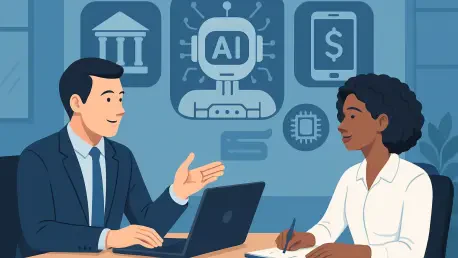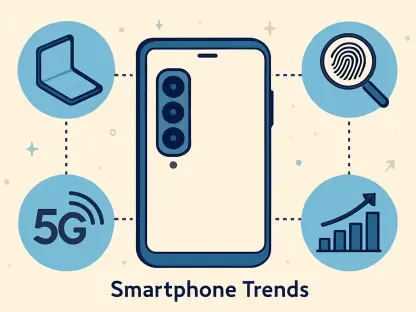In an era where artificial intelligence is rapidly redefining the boundaries of human work, a seismic shift is underway in industries like banking and consulting, driven by cutting-edge developments from OpenAI. This pioneering organization is crafting specialized AI models, codenamed Argentum for consulting and Mercury for banking, to tackle entry-level tasks with a precision and depth that surpass traditional tools. Trained with insights from over 150 former consultants from elite firms like McKinsey & Co. and more than 100 ex-investment bankers from institutions such as JPMorgan Chase, these models aim to transition AI from a mere assistant to a functional co-worker. This evolution signals a profound change in how businesses operate, promising to reshape workflows and challenge long-standing notions of junior roles. As enterprises increasingly seek tailored solutions, the impact of such advancements could redefine productivity, yet it also raises critical questions about integration and adaptation in high-stakes sectors.
Redefining Roles with Specialized AI
The push for AI that goes beyond generic capabilities is gaining momentum, and OpenAI is leading the charge with models designed to deliver industry-specific results in banking and consulting. Unlike earlier systems that offered broad, surface-level assistance, Argentum and Mercury are being equipped with deep expertise drawn directly from seasoned professionals. This approach reflects a broader trend among global businesses to view AI not just as a cost-saving mechanism but as a collaborative partner capable of meaningful contributions. Industry analyst Sanchit Vir Gogia from Greyhound Research points out that 68% of decision-makers now expect AI to provide structured, actionable outputs. By embedding real-world know-how into these systems, OpenAI is positioning its technology to meet the nuanced demands of complex sectors, potentially replacing tasks traditionally handled by entry-level staff with automated precision.
This shift toward specialization is not merely technological but also strategic, aiming to align AI outputs with the unique needs of enterprises. The training process for these models involves intricate datasets that capture the judgment and decision-making patterns of experienced consultants and bankers. Such a focus ensures that the AI can handle tasks like financial analysis or strategic planning with a level of competence that mirrors human expertise. However, this raises intriguing implications for the workforce, as businesses must now grapple with redefining roles and responsibilities. While the promise of efficiency is undeniable, the transition to relying on AI for core functions requires a careful balance to maintain quality and trust in critical operations. OpenAI’s efforts mark a significant step toward a future where technology and human effort are more intertwined than ever before.
Navigating the Integration Hurdles
Despite the transformative potential of OpenAI’s AI models, integrating these systems into existing business frameworks presents substantial challenges that cannot be overlooked. Craig Le Clair of Forrester has identified a persistent issue known as “Proof of Concept purgatory,” where many AI initiatives fail to move beyond trial stages to deliver real value. Statistics reveal that 60% of enterprises struggle with this bottleneck, largely due to the “Action Gap”—a disconnect between the insights AI generates and the practical steps needed to drive business outcomes. This gap often results in underwhelming returns on investment, as companies find themselves unable to seamlessly incorporate AI recommendations into their workflows. OpenAI’s specialized models aim to address this by producing more relevant outputs, but the road to effective implementation remains fraught with obstacles.
Beyond technical issues, the integration challenge also encompasses operational and systemic barriers that businesses must navigate. Many organizations lack the infrastructure to support advanced AI tools, leading to delays and inefficiencies even when the technology itself performs well. The risk of over-reliance on AI without proper validation processes can further complicate matters, especially in regulated industries like banking where accuracy and compliance are paramount. Addressing these hurdles requires not just better technology but also a rethinking of how workflows are designed and managed. Enterprises need to invest in training staff to work alongside AI, ensuring that human oversight complements automated processes. Only through such holistic strategies can the full potential of models like Argentum and Mercury be realized, turning theoretical promise into measurable impact.
Cultural Shifts and Organizational Realities
The introduction of AI into sectors like banking and consulting is not just a technological upgrade but a profound cultural shift that reshapes workplace dynamics. Real-world applications, such as a bank employing AI to draft credit memos or a consulting firm using it for market sizing, demonstrate both the potential for productivity gains and the pitfalls that accompany such innovations. Issues like compliance discrepancies and uncertainty over the roles of junior employees often emerge, highlighting the need for structured oversight. Without clear guidelines, the adoption of AI can lead to confusion and inefficiency, undermining the very benefits it seeks to deliver. Experts stress that success hinges on creating frameworks that integrate AI responsibly, ensuring that it enhances rather than disrupts established processes.
Moreover, the financial burden of adapting to AI-driven environments is significant and often underestimated by organizations eager to embrace innovation. Le Clair notes that for every dollar spent on AI licensing, nearly five dollars are invested in managing the resulting organizational changes, from retraining staff to redesigning workflows. This disparity underscores the importance of preparing for the human element of AI adoption, as cultural resistance or skill gaps can derail even the most advanced systems. Companies must prioritize change management, fostering an environment where employees view AI as a partner rather than a threat. In doing so, they can mitigate role ambiguity and build a workforce that is equipped to collaborate with tools like those developed by OpenAI, ensuring that the transition strengthens rather than strains operational cohesion.
Envisioning AI as Collaborative Partners
As AI technology advances, the concept of machines as intellectual peers within specific domains is becoming a tangible reality that could redefine the future of work. Le Clair warns that transitioning to a hybrid workforce—where AI matches or even surpasses human expertise in targeted areas—presents complexities that many organizations are unprepared to handle. This evolution demands a deeper understanding of how humans and machines can coexist productively, particularly in high-stakes fields like banking and consulting. Programs like Forrester’s Agent Experience initiative are stepping in to address these challenges, focusing on critical skills such as knowledge curation, change management, and oversight of AI systems. Such efforts highlight the need for new strategies to ensure that collaboration between humans and AI remains harmonious and effective.
The implications of this shift extend beyond operational efficiency to the very structure of professional roles and career paths. As AI takes on tasks once reserved for junior staff, businesses must rethink how talent is developed and deployed. This could lead to a greater emphasis on creative and strategic skills that complement automated processes, potentially elevating the value of human intuition in decision-making. However, it also necessitates a proactive approach to reskilling employees, ensuring they are equipped to handle the evolving demands of a tech-driven workplace. OpenAI’s models, with their focus on domain-specific expertise, are at the forefront of this transformation, pushing industries to adapt to a landscape where AI is not just a tool but a partner. The challenge lies in balancing technological advancement with human capability to create a synergy that drives progress.
Building a Future with Tailored AI Solutions
Reflecting on the journey of AI in enterprise settings, it’s evident that tailored solutions like those pioneered by OpenAI mark a turning point for industries such as banking and consulting. The Argentum and Mercury projects stand out as bold attempts to embed industry-specific judgment into AI, setting a precedent for how technology could replace junior roles with remarkable accuracy. Yet, the path is not without its struggles, as businesses wrestle with integration challenges and cultural adjustments to accommodate these powerful tools. Expert insights consistently point to the importance of structure and human oversight in maximizing AI’s impact, revealing that technology alone is never the complete answer to complex business needs.
Looking ahead, the next steps for organizations involve a strategic focus on bridging the gap between AI potential and practical application. Investing in robust frameworks for integration, alongside comprehensive training programs, will be crucial to ensure that AI systems enhance rather than disrupt workflows. Additionally, fostering a culture that embraces human-AI collaboration can help mitigate resistance and build a workforce ready for the hybrid future. As the legacy of initiatives like OpenAI’s models continues to unfold, businesses must commit to ongoing adaptation, leveraging lessons learned to refine their approach. By prioritizing actionable strategies and sustained investment in both technology and people, industries can unlock the full transformative power of AI, paving the way for innovation and efficiency in the years to come.









